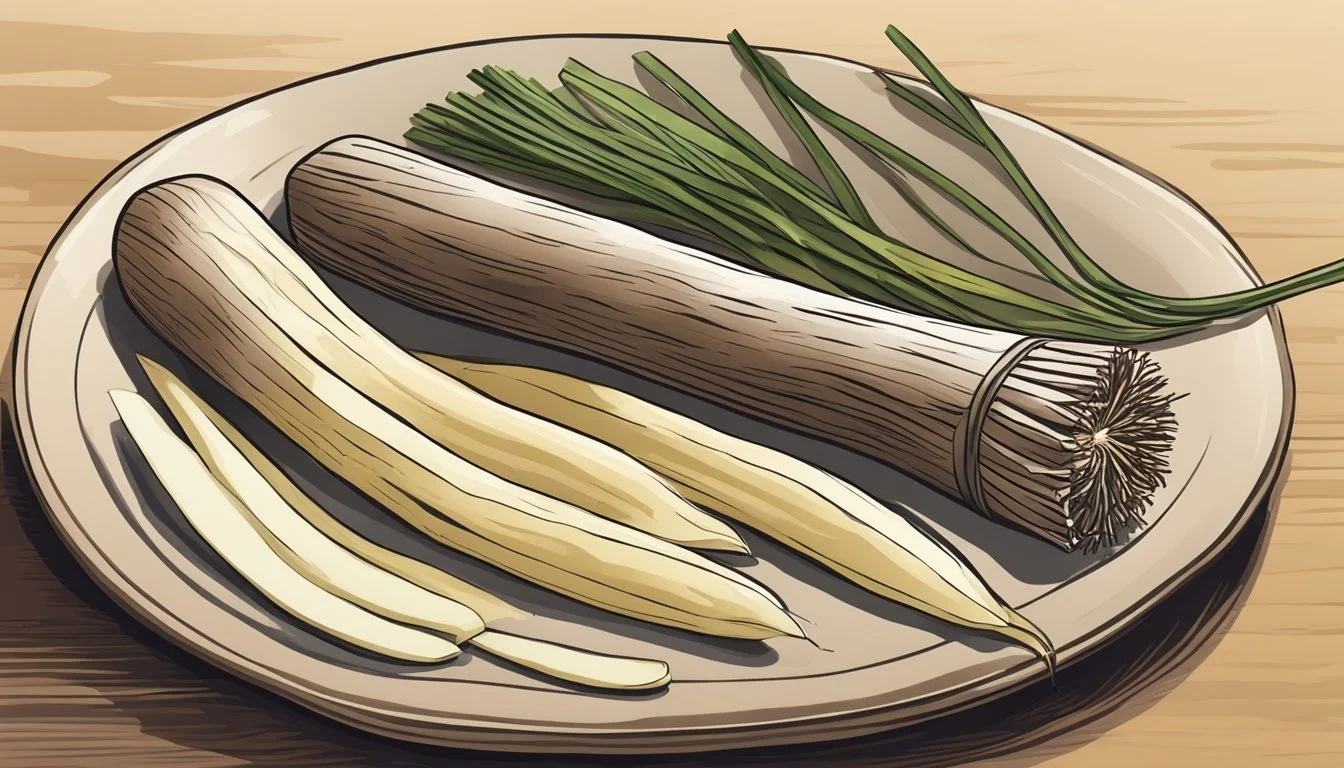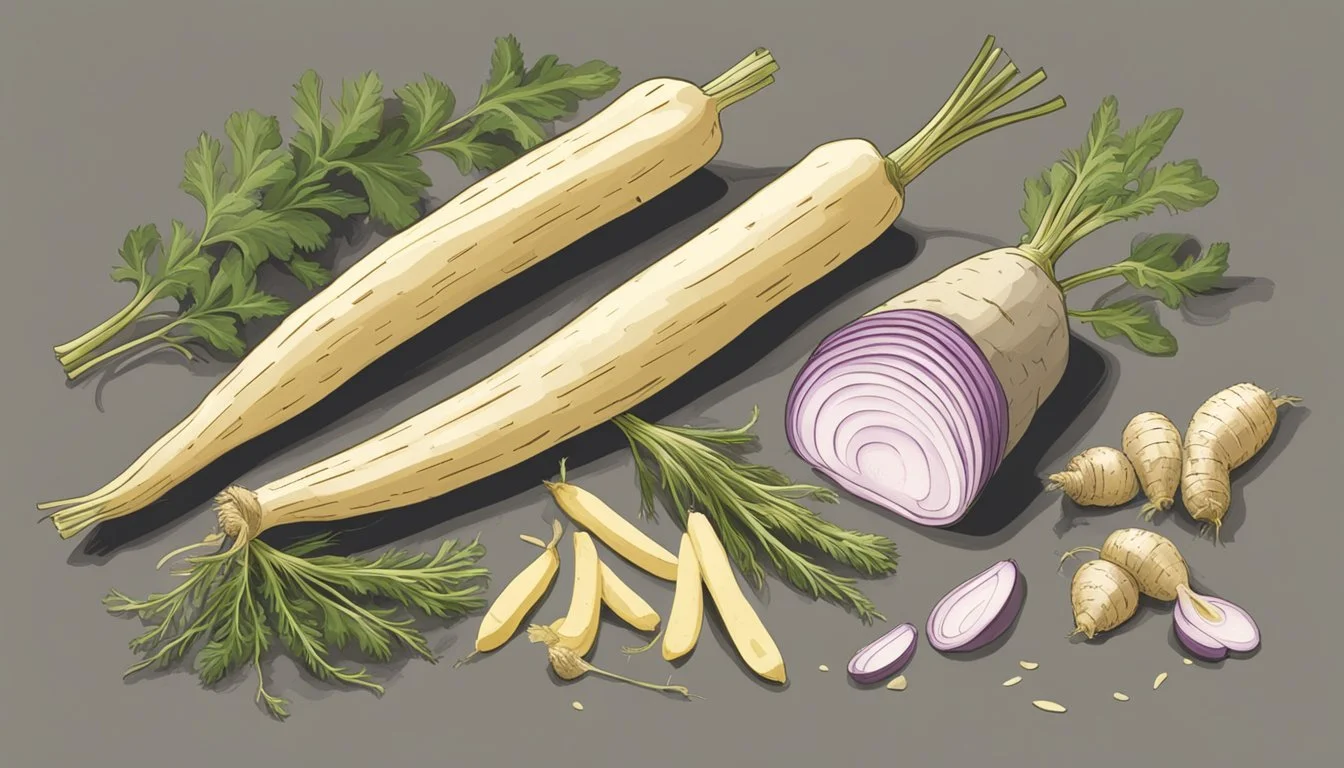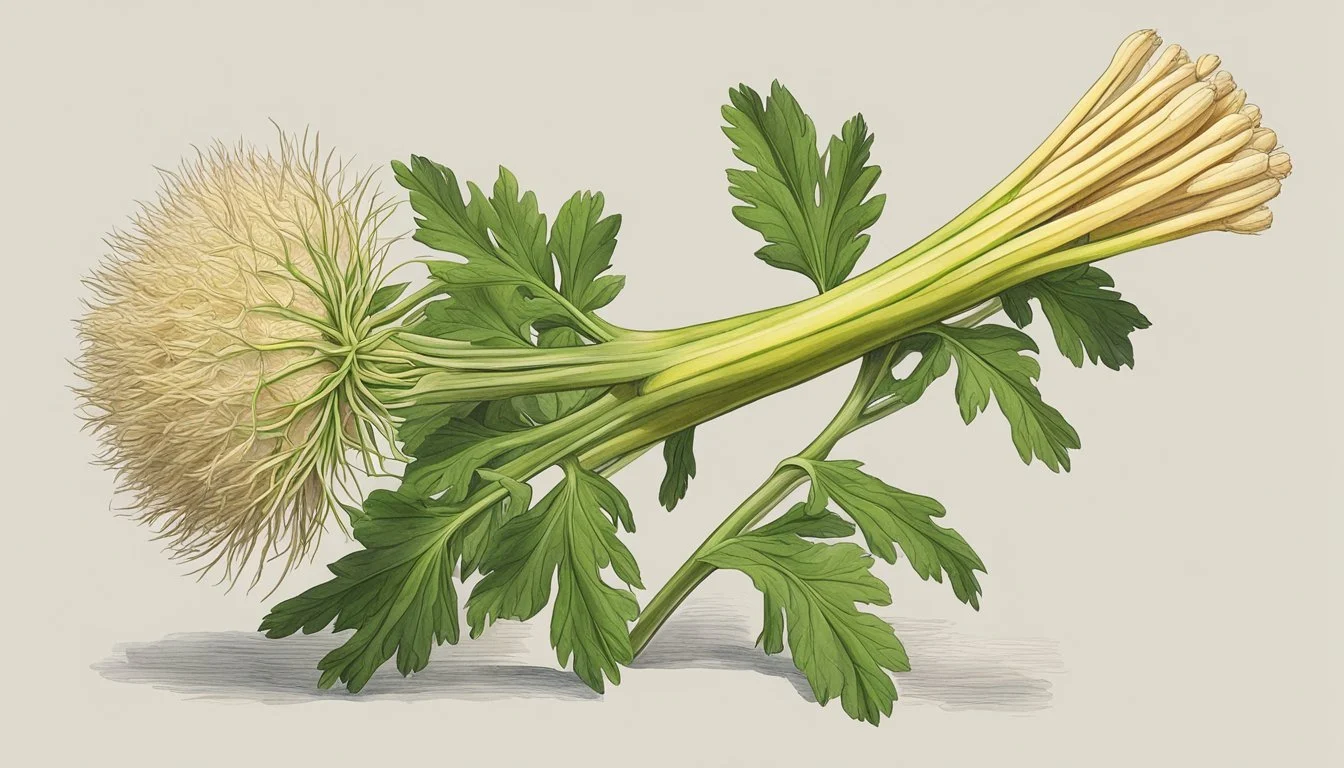How to Substitute Salsify for Parsnips
A Simple Guide for Home Cooks
Salsify, a less commonly used root vegetable, emerges as an excellent alternative for parsnips in various recipes. Boasting a similar earthy flavor and starchy texture, it adapts well to the cooking methods typically applied to parsnips. Recognized for its nutritional value, salsify contains vitamin C and dietary fiber, contributing positively to a balanced diet. Its versatility allows it to blend seamlessly into dishes where parsnips are usually the root vegetable of choice, such as stews, soups, and purees, making it a practical substitute in both flavor and function.
When substituting salsify for parsnips, it's important to keep in mind that salsify can have a slightly different taste and texture. To achieve the best culinary results, one should boil the salsify and remove its peel before using it to mimic the softer texture of cooked parsnips. Since both vegetables share a creamy and slightly sweet profile, salsify can be utilized in most recipes calling for parsnips without compromising the integrity of the dish.
Cooking with salsify may require a few adjustments in preparation. Its firmness when raw necessitates a bit more cooking time compared to parsnips. Regardless, those looking to explore different root vegetables will find salsify a worthy inclusion in their pantry. With this substitute, chefs and home cooks alike can maintain the desired flavors and textures of their beloved recipes while introducing a new vegetable to their repertoire.
Understanding Salsify
This section provides an in-depth look at salsify, exploring its basic characteristics and its nutritional content. Readers seeking to substitute salsify for parsnips will gain essential knowledge here.
Salsify: The Basics
Salsify is a root vegetable belonging to the dandelion family. It is often recognized for its long, slender shape and creamy white flesh. This vegetable is not only versatile in the kitchen but also offers an earthy taste with a hint of subtle sweetness reminiscent of artichokes. Gardeners appreciate salsify for its hardy nature, thriving in well-drained soil with full sun exposure.
Nutritional Profile
Nutrient Benefit Vitamin C Antioxidant properties, immune support Vitamin K Aids in bone health and wound healing Dietary Fiber Promotes digestive health Vitamin B6 Important for metabolism and brain health Potassium Essential for heart and muscle function
Salsify is a nutritious addition to the diet, providing a respectable amount of dietary fiber which is crucial for maintaining healthy digestion. It is also a source of vitamin C, known for its antioxidant properties and support of the immune system. Additionally, salsify contains vitamin B6, key for metabolism and brain health, and is a source of potassium, which is vital for proper heart and muscle function. Though less commonly known, salsify can be a nutritious substitute for parsnips, making it beneficial for those looking to diversify their dietary intake.
Why Substitute Salsify for Parsnips?
When a recipe calls for parsnips and they are unavailable or a different taste profile is desired, salsify can be an excellent substitute. This section explains the similarities in taste and texture between the two root vegetables and compares their health benefits.
Similarities in Taste and Texture
Both parsnips and salsify are root vegetables that share a similar consistency. Salsify, also known as the oyster plant, offers a unique taste with a mild sweetness that is akin to the sweet flavor of parsnips. They both have an earthy undertone that complements a variety of dishes. The texture of cooked salsify mirrors the starchy quality of parsnips, making it a suitable stand-in for soups, stews, and purees. The versatility in usage means that salsify can mimic the role of parsnips in most recipes without altering the dish's fundamental characteristics.
Taste Profile:
Parsnips: Sweet flavor with a slightly earthy and sometimes bitter taste.
Salsify: Mild sweetness, often described as having a hint of oyster-like taste, which is more nuanced than that of parsnips.
Texture When Cooked:
Parsnips: Creamy and soft.
Salsify: Similar to parsnips, with a tendency to be slightly crunchy if not overcooked.
Health Benefits Compared
Parsnips and salsify do not just compare favorably in taste and texture, but also in their nutritional profiles. Both vegetables are low in calories yet high in dietary fiber and vitamin C. Including salsify in meals as a substitute can offer a comparable range of health benefits. It's an excellent source of nutrients and can contribute to a balanced diet just as parsnips do.
Nutritional Benefits:
Fiber: Both provide dietary fiber, aiding in digestion.
Vitamin C: An essential vitamin in both vegetables, contributing to immune system health.
By using salsify as a substitute for parsnips, one can maintain similar flavors and textures in recipes along with enjoying the health benefits that both vegetables offer.
Culinary Applications
When substituting salsify for parsnips, chefs lean on its comparable sweetness and creamy texture. It can be used in various cooking methods where parsnips are traditionally used, including roasting, baking, and pureeing.
Roasting and Baking
Salsify can be an excellent substitute for parsnips in roasted dishes. Its sweet flavor intensifies upon roasting which makes it a suitable complement to meats and other root vegetables. To roast salsify:
Peel and slice the salsify into uniform pieces.
Toss with olive oil, salt, and any preferred seasonings.
Spread on a baking sheet and roast at 400°F until tender and caramelized.
Mashing and Pureeing
The starchy composition of salsify allows it to be effectively mashed or pureed, standing in for parsnips in recipes that call for a creamy texture. For mashed salsify:
Boil peeled salsify until it is soft.
Drain and mash with butter, cream, salt, and pepper to taste.
For a smoother puree, blend the cooked salsify with a touch of cream or stock.
Inclusion in Soups and Stews
Salsify is a robust substitute for parsnips in comfort dishes like soups and stews. Its ability to absorb surrounding flavors while contributing its own sweetness makes it a versatile ingredient. Chefs may use it as follows:
Dice and add to the soup or stew in the same stage you would add parsnips.
Cook until salsify is tender, enhancing the overall taste and adding a comforting, hearty element.
Substituting Salsify in Specific Dishes
When replacing parsnips with salsify, chefs should consider the slightly different flavor profiles and cooking times. Salsify is a versatile root vegetable that adds an oyster-like flavor to dishes and pairs well with other winter vegetables.
Vegetable Casseroles
In vegetable casseroles, salsify can seamlessly substitute for parsnips, offering a unique twist to classic recipes. It's essential to chop the salsify to the same size as other vegetables to ensure even cooking. Casseroles benefit from salsify’s ability to absorb flavors from herbs and spices, making it a complementary addition alongside carrots, celeriac, and turnips.
Root Vegetable Medley
Root vegetable medley is a dish that celebrates the earthy flavours of winter vegetables. When salsify replaces parsnips, it should be peeled and sliced similarly to ensure uniform texture. Salsify's flavor complements the sweetness of carrots and the nuttiness of rutabagas. One should consider slight adjustments in roasting times, as salsify may have a different cooking time compared to parsnips or rutabaga.
Savory Pies and Comfort Foods
In savory pies and traditional comfort foods, salsify can be used to stand in for parsnips, offering a slightly different flavor profile. For dishes that are typically mashed, such as shepherd's pie topping, salsify should be cooked until tender before mashing. The key is to cook it with a bit of sweetener if needed, as it tends not to have the innate sweetness that parsnips provide.
Handling and Preparation Tips
Substituting salsify for parsnips can be easily managed with proper handling and preparation techniques. This section provides specific tips to ensure the best outcome in both taste and texture when using salsify as a stand-in for parsnips.
Cleaning and Peeling
Salsify, often referred to as the oyster plant due to its flavor profile, requires thorough cleaning before use. Like parsnips, its skin can harbor dirt. Cleaning: It should be scrubbed well under running water with a vegetable brush. For peeling: a vegetable peeler or a paring knife works efficiently to remove its fibrous skin, revealing the creamy white interior that resembles white carrots.
Cooking Techniques
Once prepared, salsify can be cooked using techniques similar to those for parsnips. To retain crunchiness: try roasting or frying. For a soft texture: boiling or mashing with potatoes offers a comforting option. When salsify is baked, it can impart a slightly sweet flavor, closely imitating the sweet nuances of baked parsnips.
Flavor Pairing and Seasoning
Salsify's mild earthy taste pairs well with
Herbs: parsley, thyme, and rosemary.
Vegetables: carrots, celery root, and sweet potatoes (What wine goes well with sweet potatoes?).
When it comes to seasoning, salsify's versatility shines. A simple combination of salt, pepper, and olive oil can enhance its natural flavor. For a sweet touch, consider a light dusting of brown sugar before roasting, resembling the sweet flavor profile of roasted parsnips or sweet potatoes.
Frequently Asked Questions
Substituting salsify for parsnips can provide a similar earthy flavor and texture while offering unique nutritional benefits. This section addresses common queries regarding availability, handling potential allergens, and alternative uses of salsify.
Salsify Availability and Storage
Where can one find salsify, and how should it be stored? Salsify is often available in the produce section of specialty food stores or farmers' markets. Once purchased, it should be stored in a cool, dry place. If refrigerated, it can be wrapped in a damp cloth and placed in the crisper drawer to maintain its moisture content.
Storage Method Duration Notes Room Temperature 1-2 days Cool, dark area. Refrigerator 1-2 weeks In a damp cloth, crisper drawer recommended.
Managing Allergies and Intolerances
How does one manage allergies when using salsify as a parsnip substitute? Individuals concerned about food allergies should be aware that salsify is a member of the daisy family and may elicit allergic reactions in sensitive persons. It has a similar allergen profile to that of some other root vegetables like carrots and celery. Anyone with a history of vegetable allergies should consult with a healthcare provider before introducing salsify into their diet.
Creative Uses Beyond Substitution
What are inventive ways to use salsify aside from direct substitution for parsnips? Salsify can be employed in a myriad of culinary applications beyond simple substitution. It lends itself well to being roasted, sautéed, or boiled. Salsify can also be pureed into soups or stews to enhance the overall comfort and creamy texture. When diced, it can be a unique addition to a mélange of roasted root vegetables seasoned with herbs.
Soup Enhancement: Puree boiled salsify for a rich, creamy base.
Herb Pairings: Combine with herbs like thyme to complement its subtle flavor.
Nutritional Boost: Salsify has high vitamin C and dietary fiber content, along with a decent profile of vitamin A and vitamin K.
By integrating salsify into various dishes, chefs can enjoy a nutritious, fiber-rich alternative that champions a distinctive taste while providing comfort and satiety.
Conclusion
When making the switch from parsnips to salsify in recipes, culinary enthusiasts can feel confident in delivering a satisfactory taste and texture. Salsify, often praised for its likeness to artichoke in flavor, stands as a robust substitute. It should be noted, however, that salsify might possess a slightly sweeter and more complex flavor than parsnips, which are generally earthy with a slight nuttiness.
If salsify is unavailable, several other vegetables may serve as suitable replacements:
Sweet potato: Offers a creamy texture with a pronounced sweetness.
Carrot: Provides a similar crunch and a sweet, earthy flavor.
Celeriac (Celery root): Carries a subtle celery taste, excellent for mashing and soups.
Turnip: Brings a slightly spicy note to the table, yet works well in most dishes calling for parsnips.
Potato: A classic choice with a neutral flavor, suitable for almost any dish.
Here's how these alternatives compare in terms of flavor and use:
Vegetable Flavor Note Best Used In Sweet potato Sweet, creamy Mashes, bakes Carrot Sweet, earthy Roasts, soups Celeriac Subtle celery Mashes, soups Turnip Slightly spicy Stews, roasts Potato Neutral Versatile in use
They should opt for the substitute that best fits the desired flavor profile and texture of the dish. Whether the aim is to mimic the sweetness of parsnips or to simply use what's readily available, there are ample options to ensure the success of the meal. Ultimately, the choice of vegetable can add a unique twist to traditional recipes, allowing for culinary creativity and personalization.








